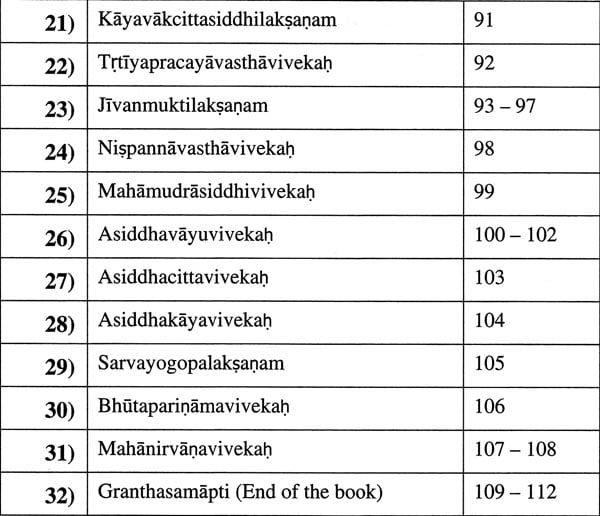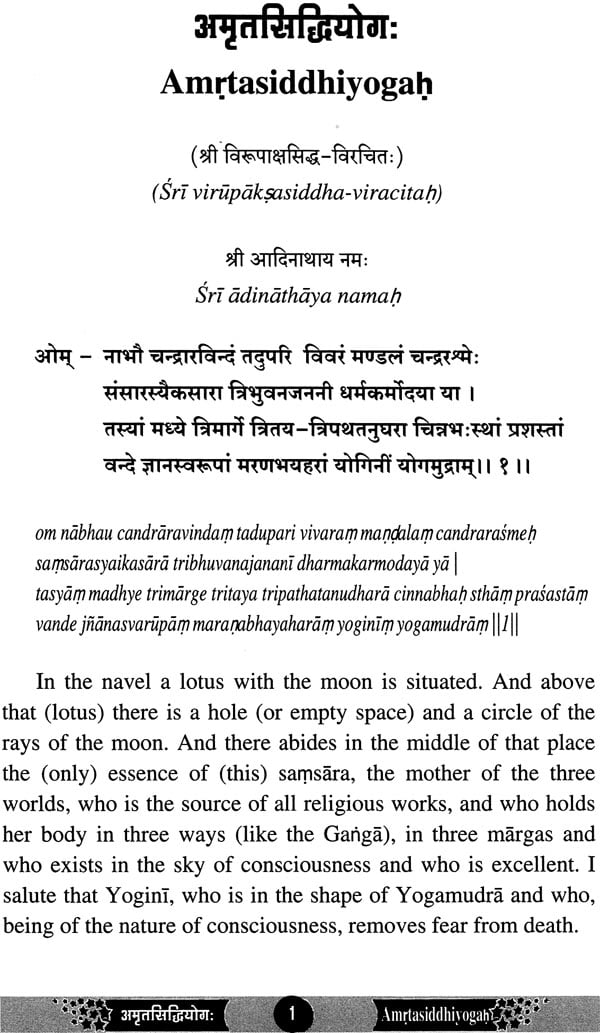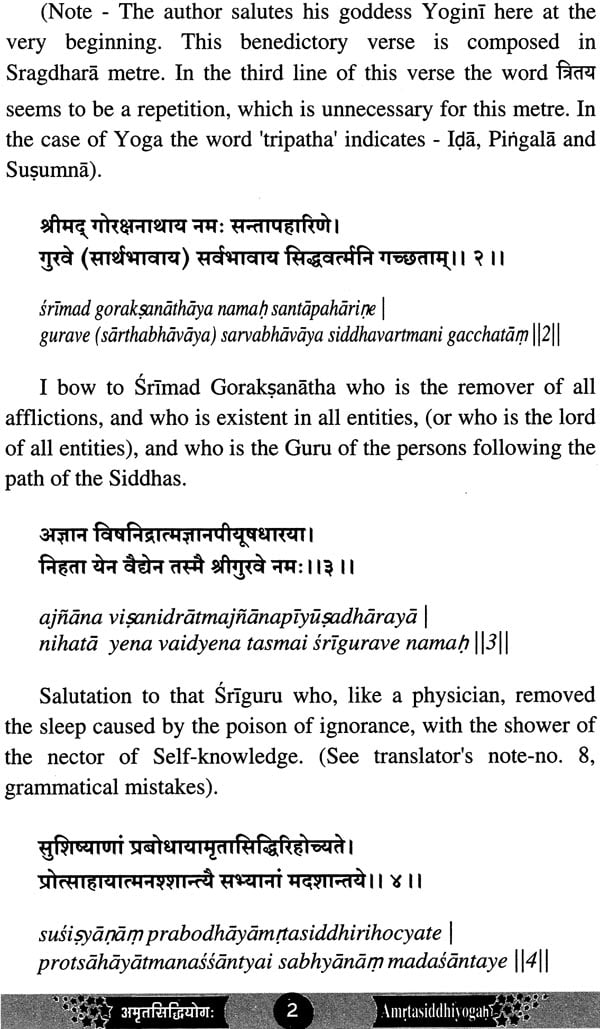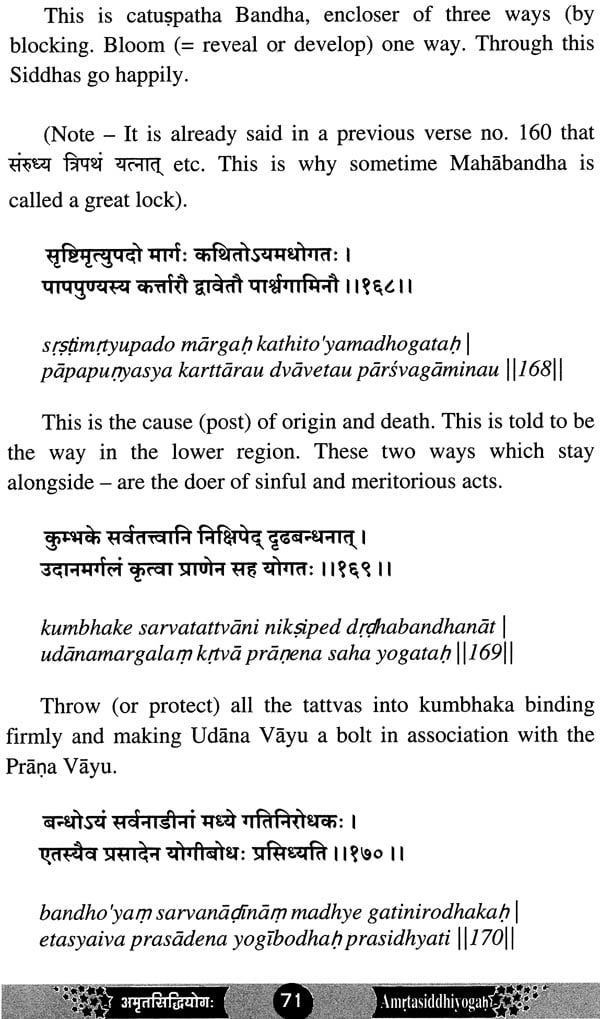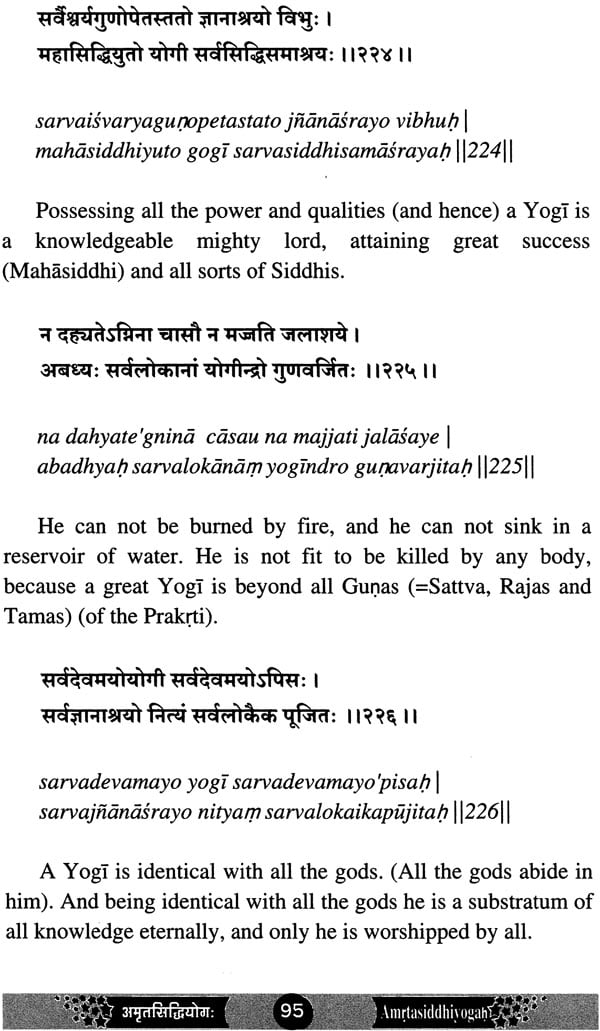
Amrtasiddhiyogah (Text. English Translation and Critical Study On The Basis of A Single Manuscript)
Book Specification
| Item Code: | NAR575 |
| Author: | Dr. Bandita Satapthy and Dr. Niradbaran Mandal |
| Publisher: | Kaivalyadhama Samiti Lonavla |
| Language: | Sanskrit Text With English Translation |
| Edition: | 2018 |
| ISBN: | 9789387198005 |
| Pages: | 130 |
| Cover: | PAPERBACK |
| Other Details | 8.50 X 5.50 inch |
| Weight | 180 gm |
Book Description
Amrtasidhiyogah is a treatise on siddhayoga. According to its colophon it is composed by a siddhayogi whose name is Virupaksa Siddha. The word ‘Siddha’ indicated that he is related to the Siddha Sampradaya. Actually the members of this sampradaya were followers of Goraksanatha who is said to have been a great were followers of Goraksanatha who is said to have been a great yogi of the Nathasampradaya. Here, in this book, Goraksanathahas been mentioned to be the guru of the siddhas. The subject matter of this book is a kind of yoga whose practitioners hold that this human body is a miniature form of the whole universe.
For it is said: ‘Trailokye yani tattvani tani sarvani dehatah…’(What exists in the three worlds can be found in human body). so the author describes, one by one, sariravivekah, candra, candrasurya, vahni, bija, citta, mahamudra, mahabandha, guna, vayu etc. The author describes some yogic bandhas and mudras and some way of meditation also for the benefit of practitioners to achieve amratasiddhi and esoteric power through the practice of them.
We offer our supplication to Lord Ganesa seeking his bountiful blessings for this small literary work. It was a great moment when we on behalf of the Philosophico - Literary-Research Department of Kaivalyadhama, have undertaken this research project on the unpublished Yoga Manuscript (MSS) known as Amrtasiddhiyogah. The Manuscript is a confluence of the thoughts of various spiritual traditions of India. Its root can be traced in the Yoga, Vedanta, Hatha and Tantra traditions.
We are highly thankful to the Government Oriental Manuscript Library, Madras, for providing us the transcribed copy of Amrtasiddhiyogah Manuscript, no. D 4342. It is available in Devanagari script at Kaivalyadhama library. The Library Accession No. 10452 which contains 30 folios and the diverse topics treated in the manuscript is divided into multiple sections.
We would like to offer the enormous gratitude to revered Swami Maheshananda, the Chairman, Sri Omprakash Tiwari, the honorable Secretary, Kaivalyadhama S.M.Y.M Samiti for their intellectual guidance.
We are extremely grateful to the Chief Executive officer of Kaivalyadhama, Sri Subodh Tiwari for his constant inspiration and support.
We thank the Ministry of H.R.D, Department of Education, Government of India, for their regular and moral support for the research works being carried out and for the overall development of Kaivalyadhama.
We are indebted to Dr. Rajeshwar Mukherjee, for his suggestions and scholarly guidance throughout this project.
Without his active support, this work would have been a figment of imagination.
We record our thanks to Dr. Raghavendra Bhat for his constant co-operation towards the fulfillment of this work.
We also hold this opportunity to thank Shri. R. K. Bodhe, Head of the Department of the Philosophico- Literary Research Department and our other colleagues Miss Anagha Kulkarni, Mrs. Sunita Owhal for their encouragement which helped us in many aspects during my work.
We extend our thankfulness to Mr. Bernard Britto for taking every pain to consolidate the work.
We are heartily grateful to Dr. B.R. Sharma and Shri G. S. Sahay for his initial advice.
We are thankful for the prompt services provided by our Library-staff Mrs. Archana Sinha, Mr. Ganesh Rajgurav, Miss Prachi and others.
This preface will not complete without expressing the sincere gratitude to all the members of Kaivalyadhama for their direct and indirect contribution. We also thank Mr. Nanda Kumar Navale and Mr. Satish Chaware for their timely printing the present work.
Amrtasiddhiyogah authored by Virupaksa is a very rare text which is a beautiful blend of the finest concepts of Hathayoga, Tantra and Advaita Vedanta traditions. These three systems of have been playing a pivotal role in facilitating a spiritual revolution throughout the world. The Hathayoga is one of the major branches of the Yoga system that teaches the practical aspects of spiritual life. 'Yoga' means the union of the jiva (the individual soul) with Paramatman (God). The word `hatha' is split into two syllables, `ha' and 'tha', and, interpreted as the 'sun' and the 'moon' or the `prana' and the `apana', the two important aspects of the pranic energy working in a living being. The Hathayoga emphasizes on the 'Yujir Yoge' paradigm whereas the Patanjala yoga upholds the 'Yuja Samadhau’ aspect.
The Hathayoga and Tantra are primarily based on the philosophy of Advaita which considers the Brahman as the only reality and the world as the manifestations. The tantra is sometimes called the Advaita Vedanta in practice.
Originally, the word `tantra' seems to have meant any science or body of knowledge. Gradually, however, it got restricted to a particular class of literature, a literature primarily devoted to the cult of Sakti or the Divine Mother and containing an amalgam of religion, philosophy, esoteric and occult rites, astronomy, astrology, medicine and prognostications. In this respect, the tantras resemble the purapas. Etymologically the word is derived from its two constituents — 'tan', to spread; `trai,' to protect — and is supposed to mean any work that spreads or dilates upon many matters like tattvas (fundamental principles) and mantras (sacred words and syllables) and through that knowledge affords protection to the votaries. The philosophy of tantrs seems to be an amalgamation and modification of the principles propounded by the Sarikhya and the Vedanta systems. The prakrti of Sankhya is material and insentient in nature. The maya of vedanta, especially of the Advaita vedanta, is an 'entity' that defines all descriptions. However, the Sakti of the tantras is a very real power of Siva, nay, Siva himself in his dynamic aspect.
All the qualities that are predicated for prakrti-maya like its being trigunatmika (comprising the three gunas — sattva, rajas and tamas) and the upadanakarana (material cause) of the world hold good for the Sakti of the tantrs also'.
Amrtasiddhiyogah text has been found as an unpublished manuscript which is written in Devanagari script. This book is given two names — one is `Amrtasiddhiyogah' another is `Siddhasopanapaddatih. This is written by Sri Virupaksanatha for the benefit of good Yogis. The author of the text was a great siddha Yogi according to the colophon of the text. It appears that Virapaksa was an accomplished Yogi and had attained the highest goal of yoga through the sincere practice of Yoga. It has been clearly stated by Brahmananda, the author of Jyotsna commentary of Hathapradipika, that all the yogis enumerated by him were siddha yogis (Accomplished Yogi). Therefore, it can be assumed that Vinipaksa was a yogi of high stature. Some verses of Amrtasiddhiyogah have also been found to be quoted by Brahmananda in his commentary Jyotsna on Hathapradipika. The fact that Virtipaksa was a Yogi of Nath cult is supported by the colophon of Amrtasiddhiyogah where he salutes Nath Gurus with the statement Srigurunathayanamah. The Natha Yogis have played a very significant role in the development of the Indian mysticism. These Yogis worshiped God as Natha, who transcends the finite as well as the infinite. The followers of Natha were expert in Yogic practices, which were aimed to obtain the ultimate goal. Name of the Virapaksa is mentioned an article on 'Influence of Nathayogis on Telugu Literature' by Prof. M. Venkata Reddy & B. Rama Rao, Bull, Ind. Hist. Med.Vol.Xiii.pp.4-15, 1983. He mentioned in his article about "NAVANATHACARITRA" (1376 A.D) in Telugu Literature that Amrutasiddhi Yoga is attributed to one Virupaksa.
Characteristics of the Manuscript:
We have obtained the information of its five manuscripts available in three different libraries. This information is found in the 'Descriptive Catalogue of Yoga Manuscript' (pub. By Kaivalyadhama, Serial No 61, Year 2005)
(I) Government Oriental Manuscript Library, Madras
(II) Dyar Library, Chenni
(III) Oriental Institute, Vadodara
All the manuscripts are in Grantha script. The present manuscript is found deposited in the Government Oriental Manuscript Library, Madras, under the Acc, No- D. No; 4342. The manuscript has been transcribed to Devanagari script, copied by Shri Subramania Sastry and compared by P. U. Ramana Rao for Kaivalyadhama Library, Lonavala. The accession number of this Manuscript at Kaivalyadhama Library is — R 653, 10452. The text appears to be complete since we find the opening sentence and colophon both. When we have examined each page, some verses have been found to be missing. It was not published earlier in a book form with translation; but has been published only as an article in Yoga Mimamsa, Vol.XLV No.1 & 2 : 49 - 101 April & July, 2013 by Sahay, G.S. on Amrtasiddhiyoga (ASY) by Virapaksa — An Introductory Study of Unpublished Yoga Manuscript. The text deciphered in the previous work has been found to be inconsistent in several aspects. Further the text has not been arranged according to the meters used in the manuscript. Moreover some of the incomplete texts have been constructed in the spirit of the present work. However as a maiden piece of work it deserves praise. Therefore, there was enough scope for working out a new book along with its translation.
**Contents and Sample Pages**

